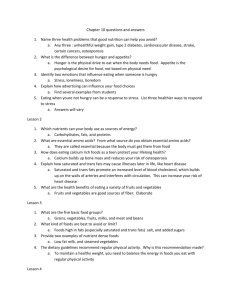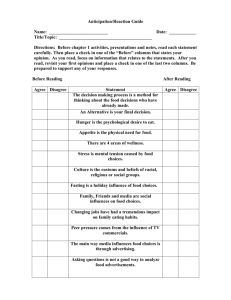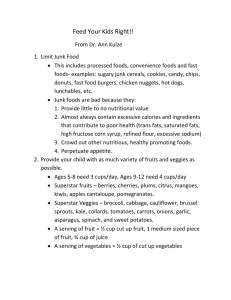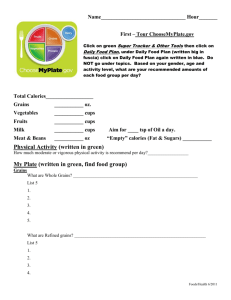Choose My Plate
advertisement
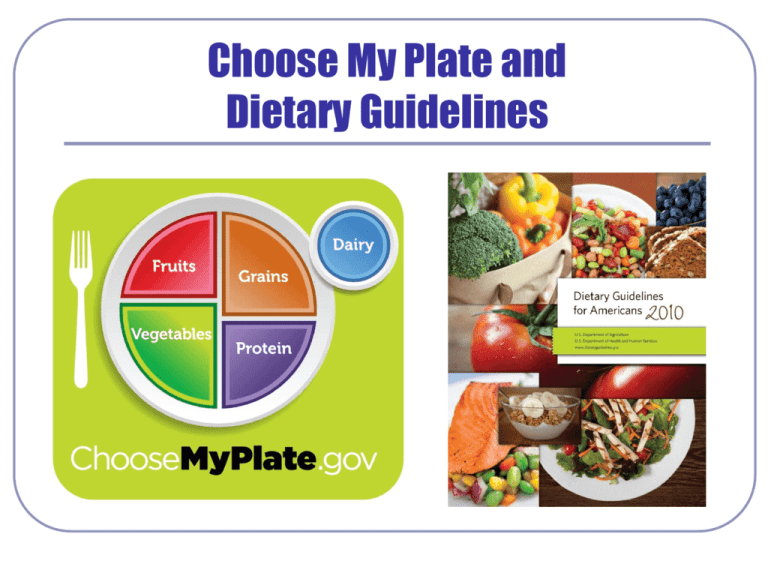
Choose My Plate and Dietary Guidelines Make half your plate fruits & vegetables Choose fresh, frozen, canned or dried fruits and vegetables Eat red, orange, and dark green vegetables, such as tomatoes, sweet potatoes and broccoli in main and side dishes Use fruit as snacks, salads or dessert Choose whole or cut-up fruits more often than fruit juice. Switch to skim or 1% milk About the same amount of calcium and nutrients but less fat and calories! Make at least half your grain whole Choose 100% whole-grain cereals, breads, crackers, rice and pasta. Check the ingredients list on food packages to find whole-grain foods. Vary your protein food choices Choose a variety of foods including seafood, beans and peas, nuts, lean meats, poultry and eggs. Keep meat and poultry portions small and lean. Try grilling, broiling, poaching or roasting. These methods do not add extra fat. Cut back on foods high in solid fats, added sugars and salt Choose foods and drinks with little or no added sugars. Look out for salt (sodium) in foods that you buy. Eat fewer foods that are high in solid fats. Eat the right amount of calories for you Enjoy your food, but eat less. Cook more often at home, where you are in control of what’s in your food. When eating out, choose lower calorie menu options. Be physically active your way Pick activities you like and start doing what you can, at least 10 minutes at a time. Every bit adds up and the health benefits increase as you spend more time being active. 10 Tips to a Great Plate Nutrients – Energy Producing Carbohydrates Provides Energy Protein Builds and Repairs Body Tissue Fat Insulation, Protection, Reserve Energy Nutrients – non energy producing Vitamins Assists in the biochemical reactions related to the metabolic process Minerals Skeletal structure Water Hydration, most essential to life Fiber Aids in digestion, can’t absorb – non nutrient How are foods sorted into groups? By Nutrient Grains Major Nutrient: Carbohydrates, Fiber Serving: 1 oz = 1 slice bread – 1 cup dry cereal = ½ cup pasta or rice Tip: Make at least ½ your grain whole grains Vegetables Major Nutrient: Vitamins, Fiber Serving: ½ cup vegetables = 1 cup leafy vegetables Tip: Make half you plate fruits and vegetables Fruits Major Nutrient: Vitamins, Fiber Serving: 1 medium/small piece of fruit = 1 cup Tip: Make half your plate fruits and vegetables Dairy Major Nutrient: Minerals, Protein Serving 1 ½ oz cheese – 1 cup milk/yogurt Tip: Switch to fat free or low-fat (1%) milk. Proteins Major Nutrient: Protein Serving: 1 oz meat = 1 egg = 1 T peanut butter = ¼ cup cooked beans = ½ oz nuts or seeds Tip: choose low fat or lean meats, bake, broil or grill. Vary protein. Oils Major Nutrient: Fat Tips: Use canola or olive oil, watch for it in foods such as nuts, olives, mayonnaise, salad dressing Fats and Oils FATS Fats are solid at room temperature Saturated fat Cholesterol Trans fatty acids Typically not so good for you OILS Oils are liquid at room temperature Monounsaturated fat Polyunsaturated fat Usually a better choice Empty Calories Calories from solid fats and/or added sugars. Solid fats and added sugars add calories to the food but few or no nutrients Recommendations for Physical Activity Kids 2-5 – Let them play! Kids 6-17 – 60 minutes a day Adults – At least 2.5 hours a week moderate exercise Plate size history 2,000 calorie diet Food Group Daily Serving Amount Grains 6 ounces Vegetables 2.5 cups Fruits 2 cups Dairy 3 cups Protein 5.5 ounces The Dietary Guidelines 1. Eat Nutrient Dense Foods Caloric Breakdown Carbohydrates: 55-60% Fat: No more than 30% Protein: 10-15 % Average American eats too much fat, sugar, calories & sodium Average American doesn’t eat enough fiber. 2. Balance calories to manage weight Monitor food and beverage intake, physical activity and body weight. Reduce portion sizes When eating out, make better choices Limit screen time (increase your activity) 3. Reduce sodium, fats, added sugars, refined grains & alcohol What can too much salt/sodium do to your body? Can cause high blood pressure and heart disease. Where does it hide? In prepared foods (frozen, canned, etc.) 4. Increase vegetables, fruits, whole grains, milk, seafood and use oil instead of fat It’s recommended that we eat 8 oz of seafood per week 5. Build healthy eating patterns that meet nutritional needs over time at an appropriate calorie level. 6. Include physical exercise as part of healthy eating patterns


